Article in Huffington Post points to Reuters item about a Swedish-developed "inflatable helmet" that activates in the event of fall or accident - but at $450 each this seems unlikely to serve as a popular alternative for adults who choose to avoid traditional helmets, which is the intent.
I also learned that Huffington Post has a (minor) category for "bike culture." Good!
When the first diamond frame bicycles became popular in the 1890s they were often called "wheels" - the national cycling association was called the "League of American Wheelmen." We have moved from "wheels" to "bikes," but the bicycles have remained remarkably the same over more than 100 years - elegant in their efficiency and simplicity. And many of the issues that we think are new? They were around then too.
Sunday, November 21, 2010
Saturday, November 20, 2010
1906 Book - Around the United States by Bicycle

This book describes the 1904-05 trip around the United States of two young fellows - nominally to win a wager. This sort of "sponsored" bicycle adventure began in the 1890s and I was surprised to find such a trip as late as 1904 - my reading (of other books about the period) suggests that the news media became skeptical about this sort of thing and it fell out of fashion before the end of the nineteenth century. (They did follow through and publish a book, which most of these travelers failed to do.)
The full book is available online here. (It is from the Library of Congress . . . )
The rather elaborate routing to minimize their travel but hit all the required states (and territories!).

From the introduction:
Clarence M. Darling and Claude C. Murphey, age 19 and 20 respectively, left Jackson, Michigan, on May 2, 1904, to make a trip by bicycle through every state and territory within the boundary lines of the United States proper, namely, forty-five states, four territories, and the District of Columbia. The trip was the result of a wager. Upon the success of the tour a purse of five thousand dollars would be won by the two contestants providing that they lived up to all the terms and stipulations of the wager. The conditions were that they were to start on this long journey penniless, while on the trip they were neither to beg, work, borrow, nor steal, all the expenses of the tour to be met by the profits resulting from the sale of an aluminum card-receiver or ashtray, a facsimile of which is given on one of the following pages.
Below, the "souvenir" they sold to raise money as they traveled.
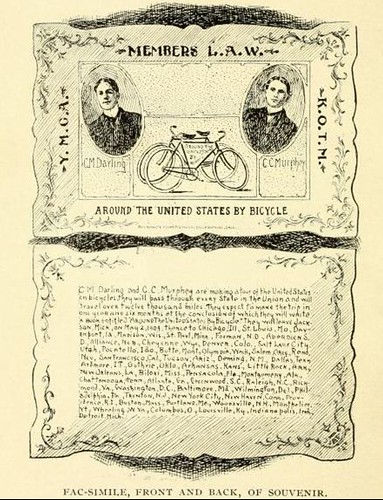
One of the few illustrations to include one of their bikes, showing a location in Washington state.
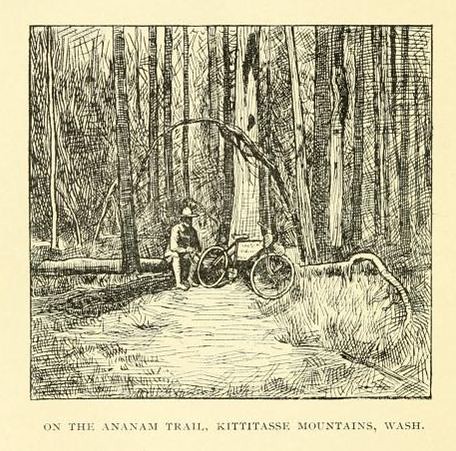
The only photo of the authors and their bikes, at the finish. Or at least I assume the authors are in this photo - but which ones are they??
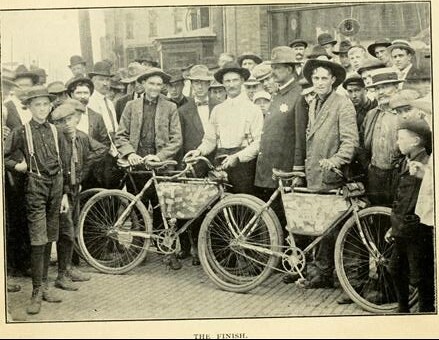
As is often the case in books reporting on trips taken by bicycle, little is said specifically bicycle-specific aspects of the travel, it is more a report of their encounters with people they met along the way and observations about places. They do not, for example, even report on their daily mileage achieved, which would seem closely connected to their winning the "wager" - but given the title of the book I suppose they figured readers would understood them to have won it, so no drama there.
Thursday, November 18, 2010
20 Percent of Bike Commuters in One Year . . .
Oregon Health Sciences University (OHSU) study that tracked bike commuters and monitored the types and severity of injuries, described in the BikePortland blog. (With a link the published study.) This text got the most interest:
Approximately 20% of bicycle commuters experienced a traumatic event and 5% required medical attention during 1 year of commuting. Traumatic events were not related to rider demographics, safety practices, or experience levels. These results imply that injury prevention should focus on improving the safety of the bicycle commuting environment.
Wednesday, November 17, 2010
Bicycle Accident on Way to Park Tool School
This article has finally appeared describing the accident that must have taken place about a half hour before I passed by this location about three blocks from where I was going to take a session of the Park Tool School (at a bike shop). The bike was still laying in the middle of the intersection and there were half a dozen police cars, so I figured the cyclist had been killed but apparently he is still alive.
One wishes for fewer car-bike accidents.
One wishes for fewer car-bike accidents.
Saturday, November 13, 2010
Winter Stuff - Gloves and Shoes (and other things)
It's all about layering. That, and keeping the fingers and toes warm. Keeping in mind that it doesn't get below 20 (F) here much.
Critical pieces
Warm riding gloves - solution: Pearl Izumi "lobster" gloves

These are relatively pricey at something over 50 bucks but if you want to ride in cold weather, essential. There is nothing worse than riding at a reasonable pace and feeling your fingers turning to ice.
Warm riding shoes - solution:
Shimano SH-RW80 Gore-Tex Cold Weather Road Shoes
Well, I didn't pay $229 for them!! But something like $150, yeah.
The good part: they are a road shoe that has the intent to keep your feet warm - typical road shoes are vented in many ways, often including holes in the soles. So yes, these are a cold weather road shoe. Also, the soles are just plastic but seem pretty stiff.
The not-so-good part. "wet weather shoe??" The shoes have GoreTex, apparently lining the inside. I don't see this does the slightest good - the shoes take in water just as fast as any other road shoe but since they are so built up, they dry out more slowly. So the wet weather role advertised is baloney, basically. But I eventually concluded that no shoes or shoes+waterproof shoe covers do this well, so I find their advertising puzzling but consider the shoes to do as good a job as is possible.
(As far as I can tell, riding in medium-to-heavy rain at a reasonable speed and avoiding getting your feet wet is impossible. I have some rubber shoe covers from Adidas and even though they have tight grippers at the ankles, water works its way down and into the shoes so that eventually my feet are completely soaked - upon arrival after a 40 minute ride I can wring out quite a bit of water from the socks. It's more like a diving wet suit - the water accumulates slowly enough in the shoe that my feet stay warm. This is not exactly how such rubber booties are advertised, however.)
I also use some neoprene half-length shoe covers over the winter shoes, particularly if it has been raining recently. These keep mud etc off the shoes.
Before I had these shoes, I used regular road shoes with zip-up in back neoprene shoe covers. Yeah, these are much less costly but they are not very durable over time and they don't do the job nearly as well.
Mostly I try not to spend lots of money on bike clothes, but for riding in winter I finally decided that having the right equipment is worth a few bucks. Low cost alternatives don't even exist for these products - but end of season sales do.
OK, one other ingredient is a good wind breaker to wear over layers. I bought one made by Cannondale ten years ago that I am still using - at the time it was like 50 bucks down from 80 because they were out of the sensible high visibility yellow - the one I have is blue (not very high visibility). It has a very high thread count, I guess, anyway it is light but wind doesn't go through it. It has side zip vents that are nice when it turns out to be more than is wanted but I don't feel like stopping and taking it off.
Yeah and I guess in addition to a pair of simple basic tights that work down to say freezing or a little below, I bought some true winter tights last summer (which worked well during "snowmagedon").
Performance Triflex Tights without Chamois worked really well - the front panels are windproof and apparently waterproof. The main drawback is that if it gets up to 40 degrees, say, these are really too warm.
(Before I had these, I would use polypropylene long underware under cycling tights - this feels odd and is neither windproof nor waterproof, so the winter tights are much better.)
Arrival at work in rain gear

I'm mostly blocking the view of my bike, alas. It's the one with the white saddle.
The main features of my wet weather strategy are to have a baseball cap under my helmet to keep water from sluicing down my face, which is quite annoying so I'm happy to do without, plus a lightweight waterproof jacket that I can take with me easily (and not GoreTex).
Critical pieces
Warm riding gloves - solution: Pearl Izumi "lobster" gloves

These are relatively pricey at something over 50 bucks but if you want to ride in cold weather, essential. There is nothing worse than riding at a reasonable pace and feeling your fingers turning to ice.
Warm riding shoes - solution:
Shimano SH-RW80 Gore-Tex Cold Weather Road Shoes
Well, I didn't pay $229 for them!! But something like $150, yeah.
Shimano's cold and wet weather road shoe with Gore-Tex and Dual Thermal lining to provide warmth and dryness.
The good part: they are a road shoe that has the intent to keep your feet warm - typical road shoes are vented in many ways, often including holes in the soles. So yes, these are a cold weather road shoe. Also, the soles are just plastic but seem pretty stiff.
The not-so-good part. "wet weather shoe??" The shoes have GoreTex, apparently lining the inside. I don't see this does the slightest good - the shoes take in water just as fast as any other road shoe but since they are so built up, they dry out more slowly. So the wet weather role advertised is baloney, basically. But I eventually concluded that no shoes or shoes+waterproof shoe covers do this well, so I find their advertising puzzling but consider the shoes to do as good a job as is possible.
(As far as I can tell, riding in medium-to-heavy rain at a reasonable speed and avoiding getting your feet wet is impossible. I have some rubber shoe covers from Adidas and even though they have tight grippers at the ankles, water works its way down and into the shoes so that eventually my feet are completely soaked - upon arrival after a 40 minute ride I can wring out quite a bit of water from the socks. It's more like a diving wet suit - the water accumulates slowly enough in the shoe that my feet stay warm. This is not exactly how such rubber booties are advertised, however.)
I also use some neoprene half-length shoe covers over the winter shoes, particularly if it has been raining recently. These keep mud etc off the shoes.
Before I had these shoes, I used regular road shoes with zip-up in back neoprene shoe covers. Yeah, these are much less costly but they are not very durable over time and they don't do the job nearly as well.
Mostly I try not to spend lots of money on bike clothes, but for riding in winter I finally decided that having the right equipment is worth a few bucks. Low cost alternatives don't even exist for these products - but end of season sales do.
OK, one other ingredient is a good wind breaker to wear over layers. I bought one made by Cannondale ten years ago that I am still using - at the time it was like 50 bucks down from 80 because they were out of the sensible high visibility yellow - the one I have is blue (not very high visibility). It has a very high thread count, I guess, anyway it is light but wind doesn't go through it. It has side zip vents that are nice when it turns out to be more than is wanted but I don't feel like stopping and taking it off.
Yeah and I guess in addition to a pair of simple basic tights that work down to say freezing or a little below, I bought some true winter tights last summer (which worked well during "snowmagedon").
Performance Triflex Tights without Chamois worked really well - the front panels are windproof and apparently waterproof. The main drawback is that if it gets up to 40 degrees, say, these are really too warm.
(Before I had these, I would use polypropylene long underware under cycling tights - this feels odd and is neither windproof nor waterproof, so the winter tights are much better.)
Arrival at work in rain gear

I'm mostly blocking the view of my bike, alas. It's the one with the white saddle.
The main features of my wet weather strategy are to have a baseball cap under my helmet to keep water from sluicing down my face, which is quite annoying so I'm happy to do without, plus a lightweight waterproof jacket that I can take with me easily (and not GoreTex).
Friday, November 12, 2010
Some Russian Bike Blogs/Sites
Let's Bike It проект по развитию велодвижения в России (Russian version) and Let's Bike It Russian cycling development project (English version). The English version is a completely different set of entries on the same topics in English. At the moment the two authors are traveling in Europe (France, the Netherlands) doing research on cycling (I suppose it is like research, anyway).
Live Streets or Живые улицы is not just about cycling but urban issues more generally, from Ekaterinburg. Russian only.
Iron Pony First is блог о велосипедной культуре в Петербурге, о которой пока что не так много можно сказать, поэтому приветы от других велосипедных культур здесь тоже будут. That is, a blog about bicycle culture in St. Petersburg (about which there isn't much to say for now . . . ). Russian only.
Cyclepedia.ru is an online Russian biking magazine, of sorts. Only in Russian. Has section for videos and various types of bikes, such as fixed gear.
Live Streets or Живые улицы is not just about cycling but urban issues more generally, from Ekaterinburg. Russian only.
Iron Pony First is блог о велосипедной культуре в Петербурге, о которой пока что не так много можно сказать, поэтому приветы от других велосипедных культур здесь тоже будут. That is, a blog about bicycle culture in St. Petersburg (about which there isn't much to say for now . . . ). Russian only.
Cyclepedia.ru is an online Russian biking magazine, of sorts. Only in Russian. Has section for videos and various types of bikes, such as fixed gear.
Thursday, November 11, 2010
Alternatives to the "Traditional" Chain
Almost all bikes today have chains that are remarkably similar to each other and to chains of 100 years ago. All chains have pins that are 1/2 inch (and not some metric distance) apart - this means that it is fairly easy to check if a chain is "stretched" without special tools. (It isn't really that the chain stretches so much as that the pins bend, resulting in a longer chain.) Simply matching up a ruler to a straight length of the chain for 12 inches will show whether the chain is longer than it should be or not. If the chain is stretched more than a few percent longer than it won't match up with the teeth on the cogs and rings and can ruin them - and chains are cheaper than cogs and rings. If you let it go long enough, chains can break - I once saw a fellow break a chain while crossing 14th St on Independence in DC. Rather an abrupt stop.
I'm told that at some time in the 1990s Shimano introduced a chain with one centimeter between pins - the resulting links were closer together and of course the cogs and rings had to be with teeth that were also closer together. Like many "innovations" that represent a pointless departure from traditional approaches, it didn't catch on.
An idea that is presented as new but is actually from the 1890s is to replace the chain and rings with a drive shaft - in other words, before there were cars with drive shafts, there were bicycles with them. Wikipedia's article on bicycle chains notes that a bicycle chain is more than 98 percent efficient in transmitting power, so the big problem with other systems has been that they are usually less efficient.
This 1900 catalog has a shaft drive bike listed first:
At 65 dollars, the shaft drive bike is the most expensive model that this company was selling at the time. Presumably the big plus was that the shaft drive was cleaner than a chain, and for women didn't require netting over the rear wheel and chain guards to keep skirts out of the chain system. One suspects the absence of systems to demonstrate the lesser efficiency may have also contributed to a continuing interest in chain drives. Note that the drive shaft took on the role of the right side chain stay in the bike's structure.
For whatever reason, some early bicycle manufacturers pushed shaft drive bicycles for some time. They were even used by cycle racers - the African American rider Major Taylor rode shaft drive bikes in races, for example. But eventually they fell out of favor - for one thing, they were always more expensive than the comparable model with a chain. Also, removal of a rear wheel to work on a flat tire appears to be more complicated on a bike with a chain drive.
Notwithstanding all that, there have been attempts in recent years to introduce bikes with shaft drives, generally on bikes where the perceived lower maintenance and cleaner aspect of a shaft drive would be attractive, usually paired with an internal hub shift system.
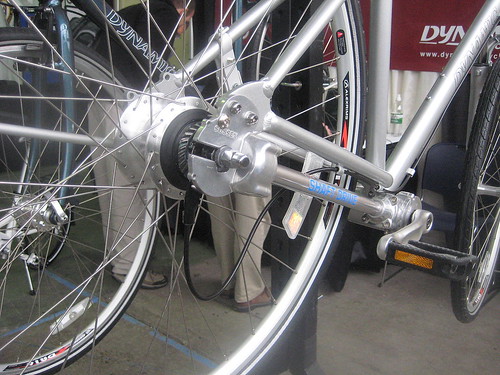
In this modern example, there is a chain stay and the drive shift.
Another, probably more sensible approach is to use a drive belt to replace the chain. The belt is based on timing "chain" (or belt) technology developed for cars and these belts are incredibly strong - and require no grease or lubrication, so they stay clean. Ixi Bikes makes a small easy-to-disassemble (but not folding) bike with a belt. Trek makes several different full size bikes with belt drives, such as the District single speed, below. The belt drive seems to be pricey compared to a chain but is almost certainly just as efficient.
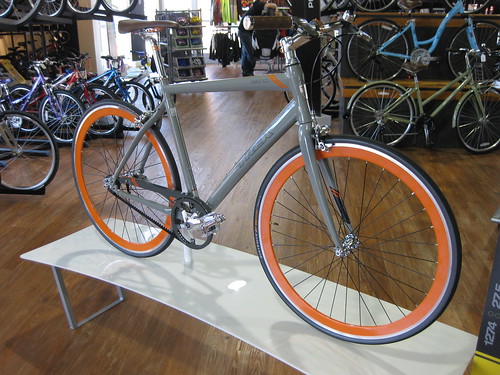
I'm told that at some time in the 1990s Shimano introduced a chain with one centimeter between pins - the resulting links were closer together and of course the cogs and rings had to be with teeth that were also closer together. Like many "innovations" that represent a pointless departure from traditional approaches, it didn't catch on.
An idea that is presented as new but is actually from the 1890s is to replace the chain and rings with a drive shaft - in other words, before there were cars with drive shafts, there were bicycles with them. Wikipedia's article on bicycle chains notes that a bicycle chain is more than 98 percent efficient in transmitting power, so the big problem with other systems has been that they are usually less efficient.
This 1900 catalog has a shaft drive bike listed first:
The superiority of bevel gears for power transmission in the bicycle has become established beyond question.Actually this is clearly not true, but the next statement about how well the shaft drive lasts (29,000 miles!) compared to a chain of those days was probably a strong favorable consideration.
At 65 dollars, the shaft drive bike is the most expensive model that this company was selling at the time. Presumably the big plus was that the shaft drive was cleaner than a chain, and for women didn't require netting over the rear wheel and chain guards to keep skirts out of the chain system. One suspects the absence of systems to demonstrate the lesser efficiency may have also contributed to a continuing interest in chain drives. Note that the drive shaft took on the role of the right side chain stay in the bike's structure.
For whatever reason, some early bicycle manufacturers pushed shaft drive bicycles for some time. They were even used by cycle racers - the African American rider Major Taylor rode shaft drive bikes in races, for example. But eventually they fell out of favor - for one thing, they were always more expensive than the comparable model with a chain. Also, removal of a rear wheel to work on a flat tire appears to be more complicated on a bike with a chain drive.
Notwithstanding all that, there have been attempts in recent years to introduce bikes with shaft drives, generally on bikes where the perceived lower maintenance and cleaner aspect of a shaft drive would be attractive, usually paired with an internal hub shift system.

In this modern example, there is a chain stay and the drive shift.
Another, probably more sensible approach is to use a drive belt to replace the chain. The belt is based on timing "chain" (or belt) technology developed for cars and these belts are incredibly strong - and require no grease or lubrication, so they stay clean. Ixi Bikes makes a small easy-to-disassemble (but not folding) bike with a belt. Trek makes several different full size bikes with belt drives, such as the District single speed, below. The belt drive seems to be pricey compared to a chain but is almost certainly just as efficient.

Subscribe to:
Comments (Atom)